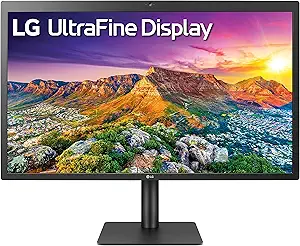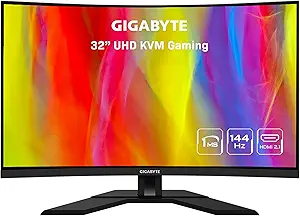GigaByte Monitors and LG Monitors are two highly recognized brands in the monitor market, each offering their unique features and technologies. GigaByte Monitors are known for their gaming-centric designs and features. They have recently introduced the AORUS series, which is equipped with the latest technologies like the 1ms response time, 165Hz refresh rate, and AMD FreeSync technology. This makes them ideal for hardcore gamers who require high-speed performance and smooth gaming experiences. However, one downside is that they are relatively more expensive compared to other brands offering similar specifications. On the other hand, LG Monitors are well-regarded for their versatile range and innovative technologies. They have recently launched the UltraFine series, which boasts 4K and 5K resolutions, making them perfect for professional photographers, graphic designers, and videographers. LG monitors also feature the latest USB-C connectivity for seamless integration with other devices. However, one of the drawbacks of LG monitors is that they don't offer as many gaming-specific features as GigaByte monitors. When compared to other brands, LG Monitors are known for their superior color accuracy and display quality, but they may not be the first choice for users who prioritize gaming performance.
GigaByte has carved a niche for itself in the gaming monitor market, consistently pushing boundaries with innovative features and high-performance displays. With a focus on catering to the needs of gamers, GigaByte monitors often come equipped with high refresh rates, low response times, and advanced gaming-centric technologies like AMD FreeSync and NVIDIA G-Sync compatibility. The Aorus lineup, in particular, stands out with its bold designs, RGB lighting, and immersive gaming experiences. Whether you're diving into the world of competitive esports or exploring vast virtual landscapes, GigaByte monitors promise to elevate your gaming experience to new heights.
LG, a stalwart in the electronics industry, brings its legacy of excellence to the realm of monitors. Renowned for their impeccable color accuracy, crisp image quality, and sleek designs, LG monitors cater to a diverse audience, including professionals, content creators, and everyday users. The UltraGear series caters to gamers with high refresh rates and adaptive sync technologies, while the UltraFine lineup targets creative professionals with stunning 4K and 5K resolutions, HDR support, and wide color gamuts. LG's commitment to innovation is evident in features like Nano IPS panels, which deliver vibrant colors and wide viewing angles, making every visual masterpiece come to life with unparalleled clarity and precision.
Affordability
When it comes to the aspect of price, both GigaByte and LG monitors offer a range of options to cater to different budget requirements. GigaByte monitors are known for their cost-effective pricing, especially in their gaming range. Their latest model, the GigaByte M27Q, is priced competitively and offers features such as a 170Hz refresh rate, 2560x1440 resolution, and an IPS panel, making it a great value for money. However, the brand lacks options in the higher-end segment, which may be a drawback for users seeking premium features. On the other hand, LG monitors are priced slightly higher but they justify this with their advanced technologies and superior features. For instance, the LG 27GL850-B model comes with a Nano IPS display, 144Hz refresh rate, and 1ms response time, offering a premium viewing experience. LG also offers a wider range of options in the high-end segment, including 4K and 5K monitors with cutting-edge features like HDR10 and USB Type-C connectivity. However, this high pricing might not be appealing to budget-conscious customers. Compared to other brands, both GigaByte and LG offer competitive pricing, but LG certainly has an edge in the premium segment.
Reputation
GigaByte and LG are both reputable brands in the monitor market, each with their unique strengths and weaknesses. GigaByte monitors are well-known for their gaming-centric features, such as high refresh rates and low response times, which are highly appreciated by the gaming community. They also offer advanced technologies like G-Sync and FreeSync for smoother gameplay. However, some users have reported issues with quality control and customer support, which can potentially tarnish the brand's reputation. On the other hand, LG monitors are renowned for their excellent color accuracy and wide viewing angles, making them ideal for professional photo and video editing tasks. They also offer monitors with cutting-edge technologies like Nano IPS, HDR10, and Thunderbolt 3 support. LG's UltraFine series, in particular, has been praised for its exceptional performance and integration with Apple devices. However, LG monitors are often more expensive than their competitors, which might deter budget-conscious consumers. Despite this, LG's reputation for quality and innovation remains strong in the industry. Comparatively, both brands hold a solid reputation, but they cater to different user needs and preferences.
Picture Quality
GigaByte and LG are two prominent brands in the monitor market, each offering a range of models with varying picture quality. GigaByte monitors, particularly the AORUS series, are renowned for their high refresh rates and resolution. They utilize advanced technology such as Quantum Dot (QLED) and High Dynamic Range (HDR) to deliver vibrant, lifelike images. However, some users have reported issues with color accuracy and consistency, which could be a drawback for professionals working in graphic design or video editing. On the other hand, LG monitors are recognized for their exceptional picture quality, especially in their UltraFine and Nano IPS models. These monitors offer excellent color accuracy and wide color gamut, making them ideal for professional use. LG's 4K and 5K resolutions, coupled with HDR technology, provide stunning detail and depth of color. However, while LG monitors excel in color performance, they often have lower refresh rates compared to GigaByte monitors, which could be a disadvantage for gamers or those requiring high-speed performance. It's worth noting that both brands offer a variety of models to suit different needs and preferences, and the picture quality can vary significantly between different models within each brand.
Production Selection
When it comes to the selection of products, both GigaByte and LG offer a wide range of monitors, each with their own unique features and technologies. GigaByte monitors are known for their high-performance gaming monitors, such as the AORUS series, which feature high refresh rates, low response times, and AMD FreeSync technology for smooth and tear-free gaming experiences. They also offer professional-grade monitors like the M series, which are designed for content creators with features like color accuracy and USB-C connectivity. However, GigaByte's product range is relatively limited compared to other brands, focusing mainly on gaming and professional monitors. On the other hand, LG's product selection is much more diverse, catering to a wider audience. They offer everything from budget-friendly monitors for everyday use to high-end gaming monitors like the UltraGear series, which boast features like 1ms response time, NVIDIA G-Sync compatibility, and IPS 1ms GTG for fast-paced games. LG also has a strong presence in the professional monitor market with their UltraFine series, which are known for their exceptional color accuracy and clarity, making them ideal for graphic designers and photographers. Moreover, LG has been pioneering in the field of OLED and Nano IPS technology, providing superior color reproduction and contrast ratios. However, LG's diverse product range could be overwhelming for some consumers, making it difficult to choose the right monitor.
Related Videos
Conclusion
GigaByte and LG are two reputable brands in the monitor market, each with their unique strengths and weaknesses. GigaByte monitors, particularly their AORUS series, are renowned for their gaming capabilities. They feature the latest technologies like AMD FreeSync, 1ms response time, and 165Hz refresh rate, providing a smooth and immersive gaming experience. However, they might fall short in terms of color accuracy and consistency, which is crucial for professional graphic design or video editing tasks. On the other hand, LG monitors, especially their UltraFine series, excel in delivering stunning visuals with precise colors and sharp details, thanks to their 4K and 5K resolutions and IPS panels. They also support USB-C connectivity, allowing for quick data transfer and charging with a single cable. However, they may not be the best choice for hardcore gamers due to their lower refresh rates and response times compared to GigaByte monitors. Both brands offer a range of options to cater to different user needs, and the choice between them would largely depend on the specific requirements of the user.




















